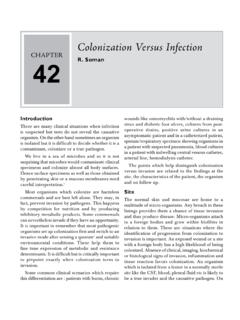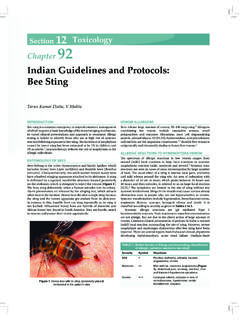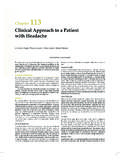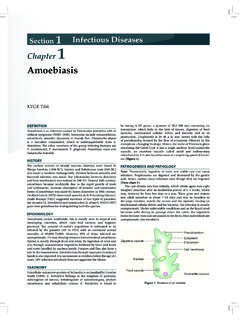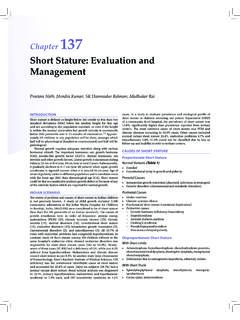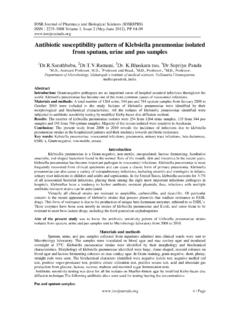Transcription of Clinical Approach to Isolated Splenomegaly 441
1 Clinical Approach to Isolated Splenomegaly44177 Clinical Approach toIsolated SplenomegalyMANORANJAN MAHAPATRA, PRAVAS MISHRA, RAJAT KUMARP atients with Splenomegaly may come to medicalattention for a variety of reasons. However, patients withno obvious explanation for an enlarged spleen presenta difficult diagnostic problem. A detailed history taking,appropriate Clinical examination and relevantinvestigations is tool for a diagnosis of investigations in most patients withundiagnosed Splenomegaly will yield a with undiagnosed Splenomegaly , who areotherwise well and who have no evidence of systemicdiseases, particularly if the spleen is minimally enlarged,may be followed with careful and regular FUNCTIONS OF SPLEENIn many instances the spleen enlarges as it performsits normal functions.
2 The four most important normalfunctions of the spleen are 1) clearance of micro-organisms and particulate antigens from the bloodstream; 2) synthesis of immunoglobulin and properdinfactors; 3) destruction of effete or abnormal RBCs; and4) embryonic hematopoiesis, which can reactivate asextra-medullary hematopoiesis in certain OF SPLENOMEGALYMany of the mechanisms of splenic enlargement areexaggerated forms of normal spleen function1. While awide variety of diseases are associated with enlargementof the spleen, 6 etiologies of Splenomegaly are consideredprimary, including 1) immune response workhypertrophy such as in subacute bacterial endocarditisor infectious mononucleosis; 2) RBC destruction workhypertrophy such as in hereditary spherocytosis orthalassemia major; 3) congestive such as in splenic veinthrombosis or portal hypertension; 4) myeloproliferativesuch as in chronic myeloid metaplasia; 5) infiltrativesuch as in sarcoidosis and some neoplasms; and 6)neoplastic such as in chronic lymphocytic leukemia andthe lymphomas.
3 Miscellaneous causes of splenomegalyinclude trauma, cysts, hemangiomas, and SIGNIFICANCE OF SPLENOMEGALYIt might be noted that spleen size is not a reliableguide to spleen function, because palpable spleens arenot always abnormal and hypersplenic spleens are notalways palpable. Patients with emphysema and lowdiaphragms commonly have palpable but normal-sizedspleens. One study showed that 63 (3%) of 2200 healthycollege freshmen had palpable spleens2 and anotherstudy showed that almost 5 percent of hospital patientswith normal spleens by scan were thought to havepalpable spleens by their physicians3. In contrast, clinicalsplenomegaly rarely noted in immune thrombocyto-penic purpura, despite avid destruction of antibody-coated platelets by the palpable Splenomegaly can be detected inonly a few patients who do not have an obviouspathophysiologic disorder, the condition should be ofinterest to the primary care physician because it isgenerally this physician who detects the presence of a palpably enlarged spleen must beconsidered a physical finding that demands with Splenomegaly may come to medicalattention for a variety of reasons.
4 Patients may complainof left upper quadrant pain or fullness or of early splenic infarct, which typically manifests with leftupper quadrant pain that sometimes radiates to the left442 Medicine Updateshoulder, can be the first clue to the existence of anenlarged spleen. Rarely, Splenomegaly can initiallymanifest with the catastrophic symptoms of splenicrupture. Some patients are found to have splenomegalyas a result of evaluation for unexplained can be discovered incidentally onphysical examination. In recent years, Splenomegaly hasbeen frequently discovered on imaging studies of theabdomen performed for other EVALUATION OF SPLENOMEGALYP hysical examination is the most practical and costeffective method of evaluation of splenomegaly4.
5 Thepresence of an enlarged spleen can be more preciselydetermined, if necessary, by liver-spleen radionuclidescan, CT, MRI, or ultrasonography. The latter techniqueis the current procedure of choice for routine assessmentof spleen size (normal = a maximum cephalocaudaldiameter of 13 cm) because it has high sensitivity andspecificity and is safe, noninvasive, quick, mobile, andless costly. CT will frequently give a better view of theconsistency of the spleen and can identify splenic tumorsor abscesses that would otherwise be scans such as gallium scans can identifyactive lymphoma or infections. The technetium liver-spleen scan can be important in identifying liver diseaseas the cause of Splenomegaly ; in patients withcryptogenic cirrhosis, a technetium liver-spleen scan thatshows higher activity in the spleen than the liver mightbe the initial hint of liver disease.
6 None of thesetechniques is very reliable in the detection of patchyinfiltration , Hodgkin s disease5. Because of thespleen s location and its propensity to bleed, needleaspiration or cutting needle biopsy of the spleen is rarelyperformed. In general, a splenic biopsy involvessplenectomy, which can be performed at the time oflaparotomy or with TO Isolated SPLENOMEGALYS plenomegaly may represent a manifestation pri-mary disease or of associated disease or probably dueto the previous illness not recognized4. The Approach tothe patient with undiagnosed Splenomegaly must beindividualized. The list of causes of Splenomegaly isformidable; the possibilities are, however, greatly redu-ced by appropriate Clinical evaluation and Approach to a patient with an enlarged spleenshould focus initially on excluding a systemic illness thatcould explain the Splenomegaly (Table 1).
7 A wide varietyof diseases can lead to splenic enlargement; common inour country are malaria, leishmaniasis, hematologicalmalignancies, congestive Splenomegaly and is a multi-disciplinary problem. Thecommon conditions that result in Isolated splenomegalycan be divided into different diagnostic groups , hepatic, infective, primary splenicconditions6. Indian data on Splenomegaly are verysparse, however, western literature6 showed theprevalence of different diagnostic groups resulting insplenomegaly were hematological: 25-66%, hepatic:12-46%, infective: 13-25%, primary splenic: 2-5% andothers: 8-21%.Proper history taking, appropriate Clinical exami-nation and relevant investigations are tool for a diagnosisof Splenomegaly .
8 A detailed history ( geographicalarea of the residence, duration of Splenomegaly ,progressively enlarged Splenomegaly , associated signsand symptoms fever, jaundice, pain abdomen, jointpain etc, history of alcoholism, family history) is essentialfor Splenomegaly evaluation. The differential diagnosisof Splenomegaly differs with the splenic size at presen-Table 1: Diagnostic Approach to Isolated splenomegaly1. Does the patient have a known illness that causes spleno-megaly*? Infections: malaria, kala-azar, infectious mononucleosisetc Hematological: hemolytic anemias, hemoglobinopathis,malignancies, myeloproliferative disorders, etc.
9 Hepatic: portal hypertension, splenic or portal veinthrombosisTreat and monitor for Search for an occult disease**. Infections: infective endocarditis Hematological: hereditary spherocytosis, polycythemiavera Hepatic: cryptogenic cirrhosis Autoimmune: systemic lupus erythematosus Storage disease: Gaucher s disease Miscellaneous: sarcoidosis, amyloidosis, tropicalsplenomegaly, splenic cystsIf found manage Diagnostic splenectomy if Systemic symptoms are present and suggests malignancy Focal replacement of the spleen on imaging studies No other sites are available biopsy4. Monitor closely and repeat studies until the splenomegalyresolves or a diagnosis is apparent if Otherwise well and no evidence of systemic diseases Spleen is minimally enlarged* Varies with age, associated features and geographical area** If patient is asymptomatic look for the causes listed in Table 4 Clinical Approach to Isolated Splenomegaly443tation in addition to the age of the patient, clinicalfeatures, associated hepatomegaly and lymphadeno-pathy.
10 As the prevalence of Splenomegaly and relativeincidence of diseases associated with it are subject togeographical variation, a clinician while evaluating apatient with palpable spleen should keep this factor one study, Swaroop, et al6 studied 317 patientswith Splenomegaly over a period of 8 years and analyzedthe association of several Clinical and laboratory featureswith different diagnostic groups. Hematological diseaseshad significant positive associations with massivesplenomegaly, lymphadenopathy and blood cytosis , leucocytosis or thrombocytosis. Hepaticdiseases had highly significant positive association withhepatomegaly, abnormal liver function tests and bloodcytopnia (as a part of hypersplenism).
